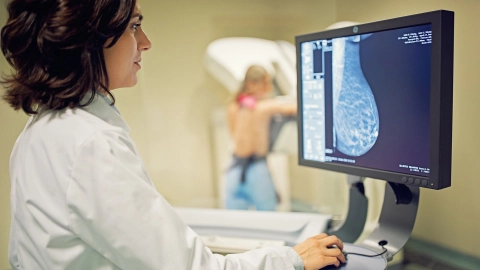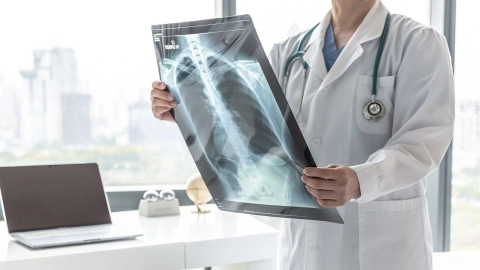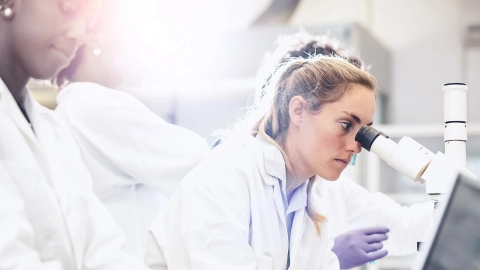Conditions Rare types of cancer
ICD codes: C17 C21 C26 C30 C31 C33 C37 C38 C39 C45 C52 C55 C57 C58 C60 C63 C65 C66 C68 C69 C72 C74 C75 C96 What are ICD codes?
Rare types of cancer affect relatively few people – fewer than 6 in every 100,000 people. This article explains how these cancers are diagnosed and treated.
At a glance
- Almost a quarter of all cancer patients have a type of tumor that is only rarely diagnosed.
- Rare types of cancer also include cancers that originate in an unusual organ or occur in conjunction with other accompanying illnesses or a pregnancy, for example.
- For some rare types of cancer, clinical trials have produced guidelines for treatment.
- For others, doctors must base their approach to treatment on information published in specialist journals.
- Some patients with a rare type of cancer are able to receive treatment as part of a clinical trial.
- Anyone diagnosed with a rare type of cancer is advised to attend a specialized center for treatment.
Note: The information in this article cannot and should not replace a medical consultation and must not be used for self-diagnosis or treatment.

What do experts mean by rare types of cancer?
Experts describe a type of cancer as rare if fewer than 6 in 100,000 people are diagnosed with it each year. There are about 200 rare types of cancer in total. According to estimates, around a quarter of all cancer patients have a rare type of cancer.
There may be various reasons why the cancer is considered rare:
- It may be a type or sub-type of cancer that only affects relatively few people.
However, doctors also describe a cancer as rare in the following cases:
- The diagnosed cancer originated in an unusual organ or tissue in the body.
- The patient is in a unique situation. For example, cancer can occur during pregnancy or a male patient may suffer from breast cancer. A cancer may also be considered rare if it occurs in someone who is of a different age to the age group that is typically affected by this cancer type.
Treatment options may be limited or ruled out entirely due to accompanying illnesses. In such cases, doctors need to identify individual solutions for their patients.
Anyone who feels unsettled when told that their type of cancer is “rare” should ask their doctor exactly what is meant by this term in this specific case.
In many cases of rare cancer types, doctors can follow treatment guidelines when formulating their treatment approach.
What symptoms can occur with a rare type of cancer?
There are no typical symptoms for rare cancer types. The symptoms depend on the area of the body that is affected by the tumor. A rare type of cancer growing close to the surface of the skin may manifest as a painless swelling or nodule. If it increases in size, presses on tissue, or even enters the nerves, feelings of tightness or pain may be felt in the region. A rare tumor originating in an internal organ may go unnoticed for a long time before any symptoms appear. Only if it begins to grow into nearby tissue or organs does it begin to cause localized symptoms and functional impairments.
If swelling or discomfort lasts for more than 4 weeks, it is imperative to consult a doctor. This can be a family doctor or a specialist consultant, depending on the location of the tumor. The physician can then start narrowing down what could be causing the symptoms or introduce any further steps needed to establish a diagnosis.
What causes rare types of cancer?
Cancer is caused by changes to the genetic makeup of a single cell. It causes the cell to multiply uncontrollably, forming a tumor. Malignant or invasive cancer is a term used to describe situations in which the cancer cells grow into (invade) the surrounding tissues and, in some cases, even break away and travel to and different part of the body to form metastases.
With most cancer patients, there is no answer as to why this happens. It is likely the result of various factors interacting with one another. It may be a matter of chance (which increases with age), but may also be due to factors such as lifestyle, environment, and genetics.
Important: It’s always advisable to follow a healthy lifestyle with plenty of exercise, to eat a balanced diet, and to avoid risk factors for developing cancer. However, this offers no guarantee that cancer won’t occur.
How are rare types of cancer diagnosed?
Rare types of cancer can occur in many different sub-forms in various parts of the body. This can make a diagnosis difficult. However, a correct diagnosis is essential to ensure the best possible treatment.
If anyone suspects they could have cancer, they should attend a treatment center that specializes in treating cancerous tumors in the specific part of the body affected. In such centers, experts from various disciplines – in particular, oncology, surgery, pathology, radiology, and radiotherapy – work together to treat patients. This is known as an interdisciplinary team.
Doctors can use various complementary procedures to diagnose rare types of cancer:
- question the patient (case history) about pre-existing conditions and symptoms
- physical examination
- laboratory analysis of blood and/or urine samples
- imaging techniques, such as computer tomography (CT), magnetic resonance imaging (MRI), ultrasound, or x-ray to determine how far the cancerous tumor has spread
- biopsy (taking a sample of tissue) and histological examinations, where pathologists examine the tissue in a lab to determine which type of cancer is present
If the histological examination indicates that the type of cancer involved may be rare, it may be recommended that the tissue samples be sent to a reference laboratory. A second opinion from an experienced pathologist can help ensure a correct classification of the cancer type.
Would you like to find out more about the diagnostic process? The website of the Cancer Information Service of the German Cancer Research Center provides an initial overview (in German).
How are rare types of cancer treated?
One of the most important pieces of information when planning treatment is to pinpoint the exact type of cancer the patient has. Doctors also need to know whether the tumor:
- is limited to one site
- has invaded neighboring tissues
- has already spread to other organs of the body, i.e., formed metastases.
These questions must be answered before choosing the most suitable treatment.
Video How is cancer treated?
The video below explains how cancer can be treated.
This and other videos can also be found on YouTube
Watch nowThe privacy policy indicated there applies.
- The tumor is limited to one area of the body or one organ and no metastases have developed yet
In this case, the top priority is usually to remove the tumor in its entirety, together with the surrounding tissue. Depending on the type of tumor involved, chemotherapy or radiotherapy may also be used to reduce the risk of relapse. - Metastases have developed
For some patients, surgery can remove not only the tumor but also any individual metastases that have developed. Chemotherapy and/or radiotherapy may also be required in some cases. Various targeted drugs and/or a clinical trial may also be considered.
More commonly, however, treatment to completely cure the cancer is no longer possible once metastases have developed. The goal is then to slow the rate of tumor growth, prevent complications, and relieve adverse symptoms. This type of treatment is referred to as palliative care. Its main goal is to ensure a good quality of life for the patient. - The cancer is not limited to one area of the body, as in the case of a rare type of leukemia or a rare lymphoma.
In this case, treatment with chemotherapy or radiotherapy, as well as targeted drugs aims to cure the cancer or at least to limit its growth and relieve symptoms.
For some rare types of cancer, clinical trials have produced guidelines for treatment. Doctors base their treatment on the results of individual clinical trials or published case reports.
Some patients with a rare type of cancer receive treatment as part of a trial.
The type of cancer involved, the degree to which it has spread, and factors known as patient factors – such as age or accompanying illnesses – all play a role in determining the treatment plan.
Important: Not every hospital is equipped to treat rare types of cancer. Patients should clarify with their doctor whether medical societies or other institutions recommend attending a specialized treatment center. Such centers have built up a considerable amount of experience in treating specific types of cancer. They also offer participation in clinical trials.
Attending a specialized treatment center often requires significant organizational and financial resources. Patients should discuss this with their health insurance provider in advance.
Would you like to know more about how rare types of cancer are treated and how to find a specialized treatment center? The website of the Cancer Information Service of the German Cancer Research Center provides an initial overview (in German).
How do patients physically recover from cancer treatment?
Treatment for cancer can take a long time to complete and can leave patients feeling very drained. Cancer patients can avail of rehabilitation (rehab) following treatment to help ease them back into everyday life:
- General oncological rehab helps patients to regain their strength.
- Rehab can also be individually tailored to the unique needs of the patient. It may have a different focus depending on where the patient is experiencing orthopedic, gynecological, neurological, or urological limitations.
- In addition, rehabilitation clinics explain to patients how they themselves can contribute to the success of their treatment – for example, through nutrition, exercise and sport, or complementary therapies.
What is meant by medical, professional, and social rehabilitation? Who can avail of rehab? You can find lots of information and reference points on aspects of cancer rehabilitation on the German Cancer Research Center’s Cancer Information Service website.
What is involved in aftercare or follow-up checks for rare types of cancer?
The type and location of the tumor and the treatment approach used all play a role in determining how patients are cared for once treatment has come to an end.
Aftercare focuses in particular on the following aspects:
- Identifying and treating any side-effects of the treatment, including complications that only occur after treatment has ended
- Detecting metastases or a relapse (recurrence of the cancer)
- Detecting secondary tumors
Once treatment has been completed, patients are examined regularly, initially at short intervals, then at longer ones. The doctors ask about symptoms, examine the patient, and perform blood tests and possibly also urine tests. Imaging tests are performed in certain situations.
Patients can talk to the doctors providing the treatment about how often they need to come for aftercare and about exactly which tests are required.
If a rare type of cancer is incurable, regular follow-up checks help identify adverse symptoms at an early stage. Doctor and patient can discuss other therapy options and support measures. The aim is to maintain the patient’s quality of life for as long as possible.
What is life like with a rare type of cancer?
Many patients want to take an active part in contributing to their recovery. There are a number of ways they can do this. What can help them to cope better with the disease and the consequences of treatment depends on the individual situation:
- Activity can help overcome tiredness and weakness. This should be adapted to the patient’s physical ability.
- A balanced, healthy diet or nutritional therapy can prevent or treat malnourishment.
- Psycho-oncological counseling can help if worries and fears become overwhelming.
What resources are available to people with rare types of cancer?
Physicians from various disciplines work closely together to treat rare types of cancer. However, centers with considerable expertise in treating a rare type of cancer frequently have no form of certification. Depending on the type of cancer involved, there may only be a few centers in Germany specializing in its treatment.
Where can treatment centers for rare types of cancer be found?
The Health Care Atlas for People with Rare Diseases (Versorgungsatlas für Menschen mit seltenen Erkrankungen) enables online searches for care facilities and reference centers for rare diseases throughout Germany.
The portal has been developed by several partners in the National Action Plan for People with Rare Diseases (“Nationaler Aktionsplan für Menschen mit seltenen Erkrankungen”, NAMSE). However, the information is not limited to cancer.
Centers can be found by entering the keyword “cancer” or the specific name of the cancer type in the search function. Support groups and other resources are listed in addition to treatment centers.
At a European level, patients can search for centers for rare types of cancer using the RARE CANCERS EUROPE network (information in English).
Do you have further questions about dealing with the condition in everyday life and additional support options? You can find information about this on the website of the Cancer Information Service of the German Cancer Research Center (in German).
For all questions about rare types of cancer, you can also make direct contact with Cancer Information Service doctors by dialing the freephone number (0800) 420 30 40 or by sending an e-mail to krebsinformationsdienst@dkfz.de.
- Allianz Chronischer Seltener Erkrankungen e.V. (ACHSE). Aufgerufen am 22.12.2023.
- Nationales Aktionsbündnis für Menschen mit Seltenen Erkrankungen (NAMSE). Aufgerufen am 22.12.2023.
- Rare Cancers Europe. Aufgerufen am 01.12.2023.
- Zentrum für Krebsregisterdaten, Robert Koch-Institut. Aufgerufen am 22.12.2023.
In cooperation with the Cancer Information Service of the German Cancer Research Center (Krebsinformationsdienst des Deutschen Krebsforschungszentrums).
As at:





